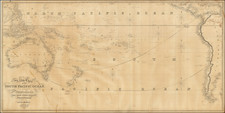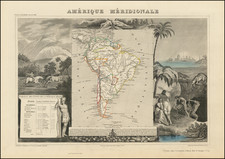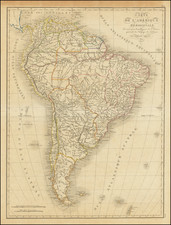John Melish's War of 1812 Map of Detroit and Environs.
Fine example of John Melish's rare and historically important map of the Theater of war in the area of Detroit, Michigan, during the early stages of the War of 1812.
Melish's map is a fascinating historical record of the dramatic action that played out along the Detroit River, one of the main focal points of the War of 1812, which was then raging between the young American Republic and Great Britain. In this respect, it is one of the most important contemporary printed maps documenting the War of 1812.
The map embraces the entire length of the Detroit River, from Lake St. Clair down to its terminus in Lake Erie, including the adjacent borderlands of Michigan and the British province of Upper Canada (later Ontario). In the upper center part of the map is the town of Detroit, then the principal American settlement in the northern Midwest. Founded by the French in 1701, the map shows Detroit guarded by a sizable citadel. Across the river, is the British-Canadian town of Sandwich (the site of modern Windsor, Ontario). It is also protected by its own fortification, while further down the river, Fort Malden guards the British town of Amherstburg. Beyond these features, the map includes details critical to military movement, notably the delineation of named roads, fords, ferries, wharfs, shipyards, and spring wells, along with the locations of obstacles such as ravines and swamps.
The War of 1812 (1812-5) was a highly controversial conflict that is even today widely misunderstood by both professional historians and the public alike. It pitted the United States, a young but ambitious republic, against the forces of Britain Empire, which in this theater included a small detachment of army regulars, Canadian colonial militia and their various Native American allies. As the British province of Upper Canada extended deeply southwards into American Territory, it was no surprise that the region featured on the present map, located at the province's extreme southwest end, would be a primary focus of the conflict.
The American army, under General William Hull, a respected veteran of the Revolution, had assembled at Detroit by the early summer of 1812. Their design was to invade southwestern Upper Canada, then seen as the soft underbelly of the Anglo-Canadian defensive plan. As shown by the notation on the map, 'Landing of the American Army without opposition 5th July 1812', the Americans crossed the river into British Territory. Subsequently, at the point labeled 'American Redoubt & Fortified Camp, evacuated' they attempted to besiege the fort at Sandwich, but soon realized that it could not be taken without heavy artillery, which was not available to them at the time. They quickly opted to retreat back across to the American side of the river.
Meanwhile, the British commander, General Sir Isaac Brock arrived on the scene, with a small force of regulars, Canadian colonists and native braves, the latter force led by the legendary Shawnee chief Tecumseh. Outnumbered and outgunned, Brock knew that victory in a direct battle would be virtually impossible, so he devised an elaborate ruse which he hoped would change the equation. He instructed his men to light innumerable camp fires and distributed surplus 'red coat' uniforms to his irregulars. This had the effect of convincing the Americans, who were continually surveying their camps from across the river with telescopes, that they were facing an enormous force of highly trained British professional troops.
Meanwhile, Tecumseh's native warriors attacked and severed the American supply and communication lines at 'Brown's Town'. The British Navy's control of the Lake Erie, pictographically symbolized by the presence of the ship 'Q. Charlotte' on the map just north of Amherstburg, made matters even worse. These factors fueled a growing sense of paranoia and confusion at Hull's Headquarters.
In a bold move, noted on the map as the 'Landingg of the British Army 10th Augt. 1812', Brock dispatched a small force to the American side, just south of Detroit. Hull feared that this was the vanguard of a combined British-Native American juggernaut, and fearing fierce treatment at the hands of the Native braves, Hull accepted Brock's gentlemanly terms of surrender. The American loss in the Siege of Detroit sent shockwaves thorough the corridors of Washington, and ensured that the invasion of Canada would not be the "mere matter of marching" predicted by Thomas Jefferson. While the Americans would regain Detroit the following year, and would subsequently mount an invasion of southwestern Upper Canada by charging up the Thames Valley, the situation on the Detroit frontier eventually settled into a tense standoff, with neither side consolidating their gains into each other's domains. In this sense, the Detroit Theater mirrored the overall progress of the war, which concluded in 1815 as status quo ante bellum.
This map, which very rarely appears separately on the market, was included in John Melish's magnificent work, A Military and Topographical Atlas of the United States (1813-5), which is considered to be the finest printed cartographic work on the War of 1812. Engraved by a young Henry Schenk Tanner, the present example, features Melish's signature color scheme, with vivid hues distinguishing terrestrial boundaries, while a brilliant blue full wash runs through the waterways.
John Melish (1771-1822) was, at the time, by far the most esteemed and influential American mapmaker, soon to be famous for his epic Map of the United States of America with the contiguous British and Spanish Possessions (1816), the first map that showed America as extending across the continent from sea to sea.
Rarity
We have had the map once before. Other than that, we know of only 1 other example on the market in the past 30 years (Arkway, 1998, Catalog 50, #174).
John Melish (1771-1822) was the most prominent American mapmaker of his generation, even though his cartographic career lasted only a decade. Melish was born in Scotland; he moved to the West Indies in 1798 and then to the United States in 1806. By 1811, he had settled in Philadelphia and published Travels through the United States of America, in the years 1806 & 1807, and 1809, 1810, & 1811, which was richly illustrated with maps.
Melish created several regional maps of the highest quality, as well as the Military & Topographical Atlas of the United States (Philadelphia, 1813, expanded 1815). The latter work is widely considered to be the finest cartographic publication to come out of the War of 1812.
By far his best-known work is his monumental map of the United States of 1816, Map of the United States with the contiguous British and Spanish Possessions. He began working on the map in 1815 and sent it to Thomas Jefferson for comment in 1816. Jefferson enthusiastically reviewed the map and returned it with his edits. Jefferson later hung an example of the map in the Entrance Hall of Monticello and sent it to associates in Europe.
Melish’s finished product was the first map of the United States to extend to the Pacific Ocean. After its publication in 1816, Melish ensured the map was as up-to-date as possible; it was reissued in 25 known states published between 1816 and 1823. The map captured the then rapidly changing geography of the United States, as well as various boundary disputes, treaties, and expansion.









![The Coast of Newfoundland From Plancentia to Cape Bonavista [and] A Draught of the River Plata in South America [and] Havana, Harbour [and] the Bay of Honda](https://storage.googleapis.com/raremaps/img/small/38599.jpg)
![[The First Maps Printed Color] Cartes en Couleur des Lieux Sujets aux tremblements de Terre Dans toutes les parties du Monde Selon le Sisteme de l’impulsion Solaire](https://storage.googleapis.com/raremaps/img/small/52293op.jpg)



